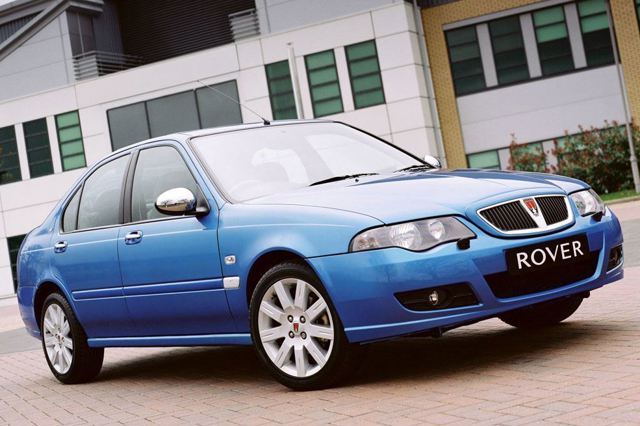Rover 45 (1999 – 2005) Buying Guide
Good
Some good reports of 1.8 CVT, eg "2001 Rover 1.8 Connoisseur with CVT box.45,000 virtually trouble free very comfortable motoring. Aircon used frequently, especially in winter. Mpg 30 mpg minimum, usually 32-34, except on long runs when its more like 37-38. Measured cut-off to cut-off. CVT marvellous, especially the automatic changedown when descending hills. Oil changed every 2 years. Hence brake pads only changed this year."
For parts, try www.britishcarparts.uk.com
www.xpartautoservicecentre.com
www.rovaparts.co.uk
www.rimmerbros.co.uk
Exhaust systems from www.longlife.co.uk
Rovers generally had slightly below average warranty repair costs in 2003 Warranty Direct Reliability index (index 93.69 v/s lowest 31.93), just beating Nissan.
Surprising but welcome 2nd best in 2006 survey at www.reliabilityindex.co.uk
Bad
Originally due for replacement late 2004, but never happened due to collapse of the company.
Testers originally thought the steering too light and the ride to soft but these have since been improved.
Non availability of some parts for some cars can result in long periods off the road.
Watch
Tips about KV6 engine in Rover 75 entry.
'K' Series engine inlet manifold 'O' rings tend to perish between 25 - 30,000 miles. Head gasket failure common on K series four cylinder engines because very low coolant capacity of engine means small leaks rapidly lead to overheating. Weakest point is water heated inlet manifold gasket. 1.8 K Series head gasket failures website link www.shame.4mg.com Bore liners of this engine can also drop.
Water level sensor kit available for the MGF and TF for £89.99 from MG Specialists such as Brown and Gammons (01462 490049) www.ukmgparts.com may also fit Rover 45.
If has ABS, fuse is on the ABS ECU inside the car and easily dislodged by clothing causing dash to show ABS fault warning.
On Rover 45 1.8 Club saloons which are fitted with Rover 75 front seats the front seat mounting bolts only bolt through standard guage metal floor and can pull through the floor.
An engineered solution to the coolant leak/head gasket problem is offered by Sterling Automotive. This involves a modified MLS (multi-layer shim) gasket, the more substantial lower oil rail (as fitted to Land Rover Freelanders) and a retro fit low coolant level warning system, with a 5 year guarantee which can be valid for up to 75,000 miles if this is reached before 5 years. In addition to this guarantee Sterling Automotive offers fixed price servicing as per the MG Rover recommendations throughout the period of cover as a reward for complying
with the conditions of the guarantee and also a free 6 monthly oil and filter change between the annual services. Sterling Automotive is currently only able to offer this on MGF/TF, Rover 25/Streetwise/MG ZR, Rover Commerce/MG Express Vans and the Rover 45/MG ZS range where fitted with the four cylinder K series engine due to the fact it is only able to provide a retro fit low coolant level system for these models but is actively seeking a way of adding the Rover 75/MG ZT 1.8 and 1.8 Turbo models to the offer as soon as possible.
XPart offers the MLS head gasket set which comes with a strengthened lower oil rail and new head bolts, as well as a water pump, from www.xpart.com In designing the new kit, XPart and SAIC have used a combination of the revised lower oil rail designed by MG Rover engineers, higher tensile 10.9 grade long stretch bolts and a new single piece multi-layer steel gasket engineered by SAIC for its new N-series engine. The gasket should not be fitted in isolation and it is the kit together with revised torque settings that provides the best known repair. The XPart parts warranty only applies when the full kit has been used.
27-9-2010: Fix for Fault with Security Control Unit. A number of owners of MG and Rover cars built between 2003 and 2005 will be aware of faults that can develop with the Security Control Unit or SCU. This commonly involves seemingly minor faults such as the horn not working or an electric window not operating but can also cause much bigger problems with the alarm, immobiliser and central locking systems which cause the car to become un-drivable. Until now rectification work has necessitated the replacement of the SCU and at times the remote handsets as well often costing £700 or more at some of the larger former Rover Dealers. However as part of Sterling Automotive's ongoing program of customer commitment, SA are always looking at new ways of making MG and Rover cars more reliable for future peace of mind and reduce the ongoing costs of motoring.
Sterling Automotive has inteoduced a new SCU repair service from just £350 including labour, components and VAT. The modified replacement parts fitted during the repair are guaranteed for 2 years which is double the time of the guarantee offered on the new SCU part. As an added bonus, if you think that your MG or Rover car might be suffering from an SCU related problem, Sterling Automotive will even carry out a free health check by appointment at its Eastbourne Service Centre to confirm if this is being caused by the SCU.
Additionally, for customers who are unable to get their car to Sterling Automotive or who reside overseas, they are also able to provide a mail order repair service. If long distance customers can remove the SCU from their car, SA advises them not to open the casing but to send it to us for repair. SA will then carry out the necessary refurbishment and repairs and return it to them for a reduced price of £320 including VAT. Postage and packing adds a further £9 within the UK, £12 within Europe or £15 for the rest of the world.
This fault can only be present on the following MG Rover vehicles; MG TF, MG ZR & MG ZS, Rover Streetwise, Rover 25 & 45 and the light commercial van derivatives, Rover Commerce and MG Express.




 Very light on fuel. Reasonable amount of kit. Tidy looks. The later ones make the better buys.
Very light on fuel. Reasonable amount of kit. Tidy looks. The later ones make the better buys.
 Felt old and outclassed, even when new. Not that roomy. K-series engines can blow their head gaskets but many have been sorted by now.
Felt old and outclassed, even when new. Not that roomy. K-series engines can blow their head gaskets but many have been sorted by now.
